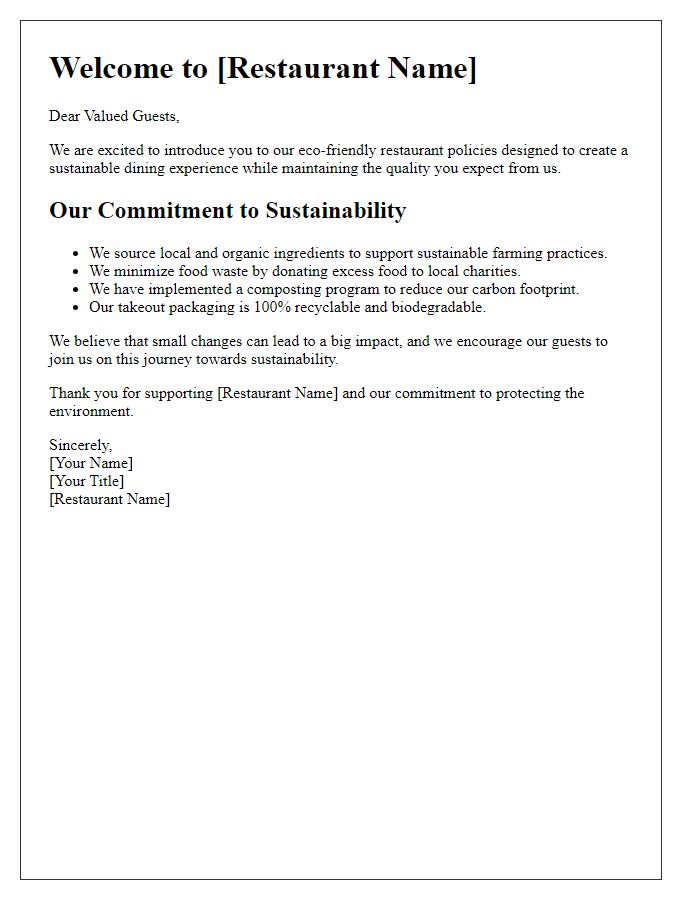Are you passionate about dining sustainably? In today's world, more and more restaurants are stepping up to embrace eco-friendly practices that not only help the planet but also enhance your dining experience. From sourcing local ingredients to minimizing waste, these initiatives are essential in creating a greener future for our communities. Join us as we explore the exciting ways restaurants are leading the charge in sustainability, and discover how you can be a part of this movement!

Clear objectives and goals
The restaurant sustainability program aims to reduce environmental impact while promoting social responsibility within the food service industry. Key objectives include decreasing food waste by implementing composting systems, aiming for a 50% reduction within one year. Increasing energy efficiency through LED lighting and energy-efficient appliances can lead to a 30% decrease in electricity consumption over two years. Sourcing locally produced ingredients from farmers' markets and regional suppliers supports the local economy while reducing carbon footprints associated with transportation. Additionally, engaging staff through sustainability training and community outreach initiatives fosters a culture of environmental awareness and responsible practices among employees. Through these goals, the program seeks to create a holistic approach that benefits the planet, the community, and the restaurant's bottom line.
Benefits to the environment and community
Implementing a restaurant sustainability program can significantly benefit both the environment and the local community. By prioritizing eco-friendly practices, such as sourcing organic and locally-produced ingredients, restaurants can reduce their carbon footprint and support sustainable agriculture. Additionally, minimizing food waste through composting programs and donating surplus food to local shelters fosters a sense of community engagement. Water conservation techniques, like low-flow fixtures or rainwater harvesting systems, contribute to preserving valuable resources in areas facing drought challenges. Furthermore, using biodegradable packaging materials reduces landfill waste and pollution, promoting cleaner urban environments. Involving local farmers and artisans strengthens community ties, stimulates the local economy, and encourages collaborative efforts toward environmental stewardship. Overall, a commitment to sustainability not only enhances a restaurant's reputation but also fosters a healthier planet and thriving community.
Implementation strategies
Sustainable restaurant practices prioritize environmental stewardship through various strategies. Utilizing locally sourced ingredients supports regional farmers and reduces carbon footprints associated with transportation. Implementing waste management systems, such as composting organic materials and recycling, minimizes landfill contributions. Energy-efficient appliances, such as Energy Star-rated ovens and refrigerators, significantly reduce electricity consumption, contributing to lower utility bills and decreased greenhouse gas emissions. Partnering with organizations that promote sustainability education enables staff engagement in eco-friendly practices, fostering a culture of environmental consciousness. Adopting digital menus can reduce paper waste, while encouraging patrons to participate in sustainability efforts enhances community involvement.
Stakeholder engagement and collaboration
A robust restaurant sustainability program fosters stakeholder engagement and collaboration essential for ecological responsibility and economic viability. Local farmers (supporting regional agriculture), environmental organizations (championing conservation efforts), and community members (advocating for local food sources) can collectively enhance sustainable practices. The integration of waste reduction strategies, such as composting food scraps and recycling materials, significantly minimizes landfill contributions. Implementing energy-efficient technologies, including LED lighting and low-energy kitchen appliances, reduces operational costs while lowering carbon footprints. Collaborating with suppliers committed to sustainable sourcing enriches supply chains and promotes ethical consumption. Regular community events focused on sustainability education enhance awareness, inviting feedback and participation from patrons invested in eco-friendly dining experiences within urban areas like New York City or San Francisco.
Monitoring and evaluation metrics
The implementation of a restaurant sustainability program requires meticulous monitoring and evaluation metrics to measure its effectiveness and impact on environmental practices. Key metrics such as waste reduction (targeting 20% decrease in food waste within the first year), energy consumption (aiming for a 15% reduction through the adoption of energy-efficient appliances), and water usage (seeking to lower by 10% through low-flow fixtures) serve as essential indicators of progress. Additional metrics may include the percentage of locally sourced ingredients (setting a goal of at least 30% of all ingredients), customer engagement in sustainability efforts (tracking participation in recycling initiatives), and employee training sessions on sustainable practices (targeting quarterly workshops). Regular assessments through these metrics will provide valuable insights, enabling informed decisions to enhance sustainability initiatives and foster a culture of environmental responsibility within the restaurant.
Letter Template For Restaurant Sustainability Program Introduction Samples
Letter template of outreach for community involvement in our sustainability efforts
















Comments